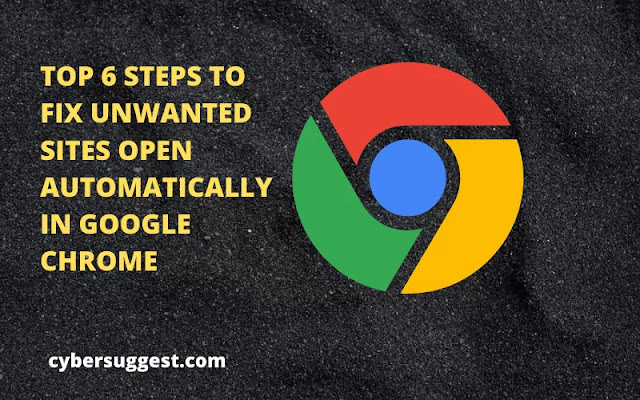Top 6 Steps to Fix Unwanted Sites Open Automatically in Google Chrome
Chrome gains a reputation as a user-friendly browser with control over things like notifications, pop-ups, and tracking data. It is normal that it may experience a hiccup or a feature may suddenly stop working. However, you should fix this when the browser starts to open unwanted sites automatically.
An adware or malicious extension is responsible for most of the hijacking of Chrome. Fortunately, there are some solutions that you can try to solve the problem. We will show you how to do it. Let's get started.
 |
| TOP 6 STEPS TO FIX UNWANTED SITES OPEN AUTOMATICALLY IN GOOGLE CHROME |
1. Run a virus scan on your computer
To stay safe, it is helpful to run a scan on your Windows 10 or Windows 11 PC using Microsoft Defender. Also, you can use MalwareByte to check if your PC or Mac is infected.
2. Use Chrome Malware Scanner
Sometimes, malware and virus infections are responsible for Chrome's tab opening problems. For this, Chrome carries its own built-in malware scanner to eliminate any such nuisance. Here's how you can run it.
Step 1: Launch Chrome and go to Settings. Scroll down to expand Advanced Settings and go to the Clean Up Computer option.
Step 2: Click the Find button to start a quick scan of your PC.
Wait for the process to finish and Chrome will notify you if it finds a malicious app or program.
3. Check the extension
Chrome is popular because of its extension support which is known to work seamlessly. However, some of them cannot be updated often. Also, poorly built extensions can often cause problems and it can automatically open the site by hijacking invalid code.
This way, you can try to remove any suspicious extensions in Chrome to see if it helps with the problem.
To remove extensions in Chrome, type chrome: // extensions / and press Enter. Look for recently installed extensions or ones that you no longer use, and click the Remove button to delete them.
Once deleted, restart Chrome to see if the issue is now resolved.
4. Clear cookies
Most websites today force you to enable cookies in your browser for a complete user experience. Unfortunately, while cookies are often considered harmless, they can sometimes carry hostile scripts, which can cause your browser to behave strangely. In this case, you can try clearing cookies in Chrome to fix the problem. Here's how.
To delete cookies in Chrome, press Ctrl + Shift + Delete to open the Clear Browsing Data menu. Now mark the checkboxes that read 'Cookies and other site data' and 'Cached images and files'. Finally, click the Clear Data button.
Restart Chrome and see if it works normally now.
5. Block POP-UPS
If Google Chrome continues to open unwanted sites for any reason, you can try to block pop-ups in Chrome. Here's how.
Step 1: Open Google Chrome on your PC and use the three-dot menu icon in the top right to select settings from the list.
Step 2: Go to the Privacy and Security tab on your left and click on the Site Settings option.
Step 3: Under Content, go to the pop-up and red instructions.
Step 4: Finally, under the default behavior, select the 'Do not allow sites to send pop-ups or redirect instructions' option.
6. Disable background applications
Background processes and extensions in Chrome help provide important information even when Chrome is not running but, at the same time, they can cause Chrome to open tabs at random. Thus, disabling them may solve the problem. Here's how to do it.
Step 1: Open Google Chrome and navigate to Settings.
Step 2: Scroll down to expand Advanced Settings. Under the system, turn off the switch next to the 'Continue background apps when Google Chrome is closed' option.
That's it. Now restart Chrome and see if the issue is now resolved.
Reset or reinstall Chrome
If other solutions don't help, you can try resetting Chrome to its default settings to fix the problem. Doing so will delete all Chrome extensions, cache, and history.
To reset Chrome, type chrome: // settings / reset in the address bar above and then press Enter. Under 'Reset and clear', click 'Restore settings to their original defaults.'
In the Confirmation pop-up box, click Reset Settings to confirm.
Resetting Chrome will clear browser cache and cookies, search engine and pinned tabs.
If you want to all-in instead of resetting, you can uninstall and reinstall Chrome. This will give you a fresh start and update Chrome in the process.

ConversionConversion EmoticonEmoticon